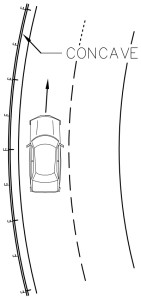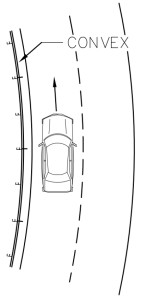Common Questions
Which is which, Concave or Convex?
Convex or Concave is always taken relative to the side that the road is to the barrier being installed.


What is NCHRP 350?
The United States of America has a set of tests developed as part of the National Cooperative Highway Research Program(NCHRP), published in 1993 as Report 350, “Recommended Procedures for the Safety Performance Evaluation of Highway Features” which is what has become to be known as “NCHRP 350”.
The crash test procedures required by AS/NZS 3845 are based on the Federal Highway Administration (FHWA) NCHRP 350 report. However, acceptance by the FHWA standard does not imply acceptance by Australian Road Authorities as AS 3845 requires additional aspects to be considered as well as any state Road Authorities specific requirements.
What are NCHRP350 Test Levels (TL) and what are their requirements?
Whilst AS/NZS 3845:1999 adopts the six test levels of TL1 to TL6, from NCHRP 350, it supplements them with a further test level TL0.
Test Level 0 has been discontinued as of AS/NZS 3845:2015 but is still commonly referenced during transition to this standard.
Test Levels for Longitudinal Barriers (TL- 0 to TL- 6)
| Test Level | Vehicle Mass (kg) and Type | Speed (km/h) | Angle (degrees) | Impact Severity (kJ) |
| 0* | 820 C | 50 | 20 | 9.3 |
| 1,600 C | 50 | 25 | ||
| 1 | 820 C | 50 | 20 | 9.3 |
| 2,000 P | 50 | 25 | 34.5 | |
| 2 | 820 C | 70 | 20 | 18.1 |
| 2,000 P | 70 | 25 | 67.5 | |
| 3 | 820 C | 100 | 20 | 37.0 |
| 2,000 P | 100 | 25 | 137.8 | |
| 4 | 820 C | 100 | 20 | 37.0 |
| 8,000 S | 80 | 15 | 132.3 | |
| 5 | 820 C | 100 | 20 | 37.0 |
| 36,000 V | 80 | 15 | 595.4 | |
| 6 | 820 C | 100 | 20 | 37.0 |
| 36,000 T | 80 | 15 | 595.4 |
(Source: AS/NZS 3845:1999 and 3845.1:2015)
LEGEND:
C = small car
P = four wheel drive or utility truck
S = single-unit truck
T = tanker type semi-trailer
V = van type semi-trailer
NOTES:
- Refer NCHRP 350 (1993) for Test Level Procedure
- TL- 4 to 6: Truck and other heavy vehicles
TL- 3: High-speed arterial roads
TL- 2: Local and collector roads
TL- 0 and 1: Work zones and low speed roads
What is the MASH standard?
The “Manual for Assessing Safety Hardware” (MASH) standard (Publication code MASH-1) was born after a 6 year review of the NCHRP350 standard.
It was released in 2009 by the American Association of State Highway and Transportation Official (AASHTO) and is now the basis of testing procedures for road safety barrier systems in AS/NZS 3845.1:2015.
This rewrite updated the test vehicle requirements, the impact condition criteria, and the evaluation criteria to reflect modern car fleets.
All barrier systems designed from 2011 will be crash tested to the MASH standard.
For further information on changes see FHWA Presentation on MASH (October 2009).
Will barriers require re-testing to the MASH standard?
Typically systems which had been approved to other testing standards such as NCHRP 350 do not require retesting to the criteria of MASH, but this is up to the local state Road Authority on review of their approved barrier systems.
What are MASH Test Levels (TL) and what are their requirements?
The below is the accepted MASH test level conditions and impact severities for Longitudinal barriers.
| Test Level | Vehicle Mass (kg) and Type | Speed (km/h) | Angle (degrees) | Impact Severity (kJ) |
| 1 | 1,100 C | 50 | 25 | 18.9 |
| 2,270 P | 50 | 25 | 39.1 | |
| 2 | 1,100 C | 70 | 25 | 37.1 |
| 2,270 P | 70 | 25 | 76.6 | |
| 3 | 1,100 C | 100 | 25 | 75.8 |
| 2,270 P | 100 | 25 | 156.4 | |
| 4 | 1,100 C | 100 | 25 | 75.8 |
| 10,000 S | 90 | 15 | 209.3 | |
| 5 | 1,100 C | 100 | 25 | 78.8 |
| 36,000 V | 80 | 15 | 595.4 | |
| 6 | 1,100 C | 100 | 20 | 49.6 |
| 36,000 T | 80 | 15 | 595.4 |
(Source: AS/NZS 3845.1:2015)